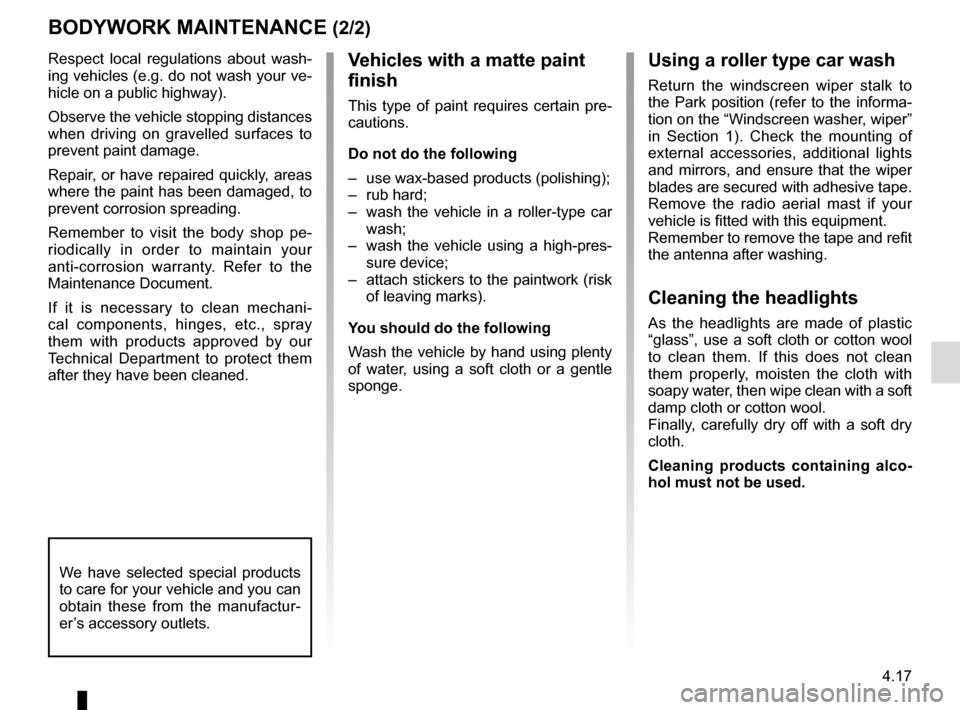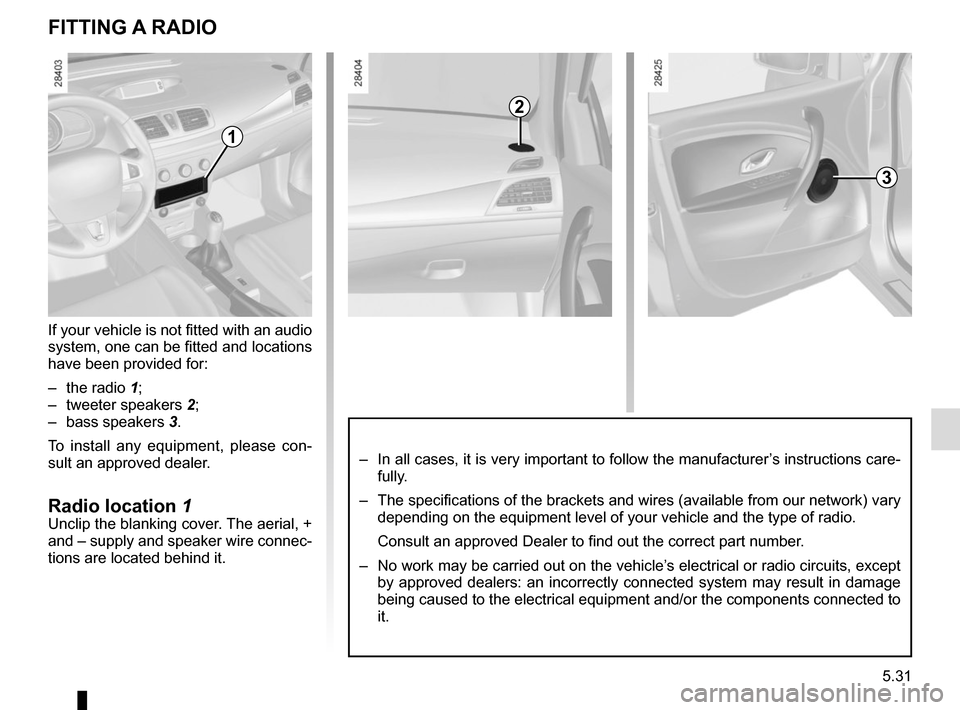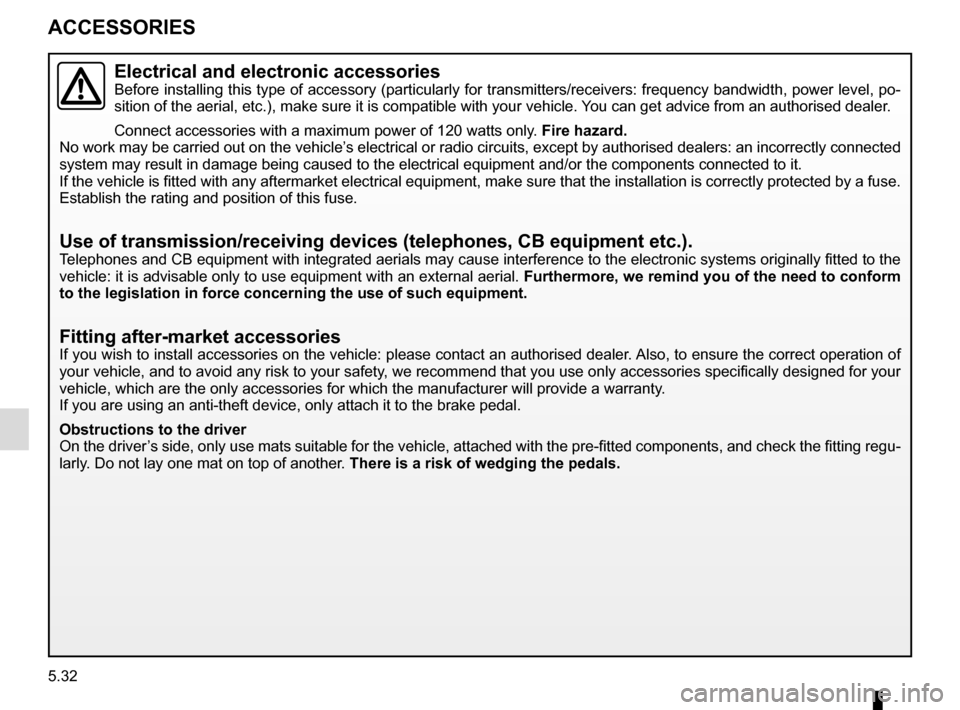2015 RENAULT MEGANE COUPE radio
[x] Cancel search: radioPage 190 of 268

4.14
The battery 1 does not require any
maintenance.Label A
Observe the indications on the battery:
– 2 naked flames and smoking are for-
bidden;
– 3 eye protection required;
– 4 keep away from children;
– 5 explosive materials;
– 6 refer to the handbook;
– 7 corrosive materials.
Handle the battery with care
as it contains sulphuric acid
which must not come into
contact with the eyes or
skin. If it does, wash the affected
area with plenty of cold water. If
necessary, consult a doctor.
Ensure that naked flames, red hot
objects and sparks do not come into
contact with the battery as there is a
risk of explosion.
BATTERY (1/2)
Depending on the vehicle, a system
continuously checks the battery charge
status. If the level drops, the message
“Battery low start engine” is displayed
on the instrument panel. In this case,
start the engine. Then the message
“Battery charging” appears on the in-
strument panel for the duration of the
charging time.
The charge status of your battery can
decrease especially if you use your ve-
hicle:
– for short journeys;
– for driving in town;
– when the temperature drops;
– after extended use of consumers (radio etc.) with the engine switched
off.
1
The engine may be hot
during operations in close
proximity. In addition, the
engine cooling fan may
start at any moment.
Risk of injury.
A
234
567
Page 193 of 268

4.17
Respect local regulations about wash-
ing vehicles (e.g. do not wash your ve-
hicle on a public highway).
Observe the vehicle stopping distances
when driving on gravelled surfaces to
prevent paint damage.
Repair, or have repaired quickly, areas
where the paint has been damaged, to
prevent corrosion spreading.
Remember to visit the body shop pe-
riodically in order to maintain your
anti-corrosion warranty. Refer to the
Maintenance Document.
If it is necessary to clean mechani-
cal components, hinges, etc., spray
them with products approved by our
Technical Department to protect them
after they have been cleaned.
BODYWORK MAINTENANCE (2/2)
We have selected special products
to care for your vehicle and you can
obtain these from the manufactur-
er’s accessory outlets.
Using a roller type car wash
Return the windscreen wiper stalk to
the Park position (refer to the informa-
tion on the “Windscreen washer, wiper”
in Section 1). Check the mounting of
external accessories, additional lights
and mirrors, and ensure that the wiper
blades are secured with adhesive tape.
Remove the radio aerial mast if your
vehicle is fitted with this equipment.
Remember to remove the tape and refit
the antenna after washing.
Cleaning the headlights
As the headlights are made of plastic
“glass”, use a soft cloth or cotton wool
to clean them. If this does not clean
them properly, moisten the cloth with
soapy water, then wipe clean with a soft
damp cloth or cotton wool.
Finally, carefully dry off with a soft dry
cloth.
Cleaning products containing alco-
hol must not be used.
Vehicles with a matte paint
finish
This type of paint requires certain pre-
cautions.
Do not do the following
– use wax-based products (polishing);
– rub hard;
– wash the vehicle in a roller-type car
wash;
– wash the vehicle using a high-pres-
sure device;
– attach stickers to the paintwork (risk
of leaving marks).
You should do the following
Wash the vehicle by hand using plenty
of water, using a soft cloth or a gentle
sponge.
Page 194 of 268

4.18
Glass instrument panel(e.g. instrument panel, clock, exterior
temperature display, radio display, etc.)
Use a soft cloth (or cotton wool).
If this does not clean it properly, use a
soft cloth (or cotton wool) slightly mois-
tened with soapy water and then wipe
clean with a soft damp cloth or cotton
wool.
Finally, carefully dry off with a soft dry
cloth.
Cleaning products containing alco-
hol must not be used under any cir-
cumstances.
Seat belts
These must be kept clean.
Use products selected by our Technical
Department (Approved outlets) or
warm, soapy water and a sponge and
wipe with a dry cloth.
Detergents or dyes must not be used
under any circumstances.
INTERIOR TRIM MAINTENANCE (1/2)
Textiles (seats, door trim, etc)
Vacuum-clean the textiles regularly.
Liquid stain
Use soapy water.
Dab lightly (never rub) with a soft cloth,
rinse and remove the excess.
Solid or pasty stain
Carefully remove the excess solid or
pasty material immediately with a
spatula (working from the edges to the
centre to avoid spreading the stain).
Clean as for a liquid stain.
Special instructions for sweets or
chewing gum
Put an ice cube on the stain to solidify
it, then proceed as for a solid stain.
A well-maintained vehicle will last
longer. It is therefore recommended to
maintain the interior of the vehicle regu-
larly.
A stain should always be dealt with
swiftly.
Whatever type of stain is on the trim,
use
cold (or warm) soapy water with
natural soap.
Detergents (washing-up liquid, pow-
dered products, alcohol-based prod-
ucts) should not be used.
Use a soft cloth.
Rinse and soak up the excess.
For further recommendations for
maintaining the interior, and/or for
any unsatisfactory results, please
see an authorised dealer.
Page 223 of 268

5.27
FUSES (2/2)
Some accessories are protected by
fuses located in the engine compart-
ment in fuse box C.
However, because of their reduced ac-
cessibility, we advise you to have your
fuses replaced by an approved Dealer.Allocation of fuses(the presence of certain fuses depends
on the vehicle equipment level)
1 Electronic parking brake;
2 Brake lights;
3 Automatic door locking;
4 Driver’s electric window;
5 Passenger compartment unit;
6 Direction indicator lights;
7 Navigation system;8 Interior rear-view mirror;
9 Rear screen wiper;
10 and 11
Rear electric windows;
12 ABS/ESC ;
13 Passenger electric window;
14 Windscreen washer;
15 Heated door mirrors;
16 Radio;
17 Luggage compartment accessories
socket;
18 Rear seat accessories socket;
19 Cigarette lighter.
C
1
2
3
4
5
6
7
8
9
10
11
12
13
14
15
16
17
18
19
Page 227 of 268

5.31
FITTING A RADIO
If your vehicle is not fitted with an audio
system, one can be fitted and locations
have been provided for:
– the radio 1;
– tweeter speakers 2;
– bass speakers 3.
To install any equipment, please con-
sult an approved dealer.
Radio location 1Unclip the blanking cover. The aerial, +
and – supply and speaker wire connec-
tions are located behind it.
– In all cases, it is very important to follow the manufacturer’s instructions care-
fully.
– The specifications of the brackets and wires (available from our networ\
k) vary depending on the equipment level of your vehicle and the type of radio.
Consult an approved Dealer to find out the correct part number.
– No work may be carried out on the vehicle’s electrical or radio circuits, except by approved dealers: an incorrectly connected system may result in damag\
e
being caused to the electrical equipment and/or the components connected\
to
it.
1
2
3
Page 228 of 268

5.32
ACCESSORIES
Electrical and electronic accessoriesBefore installing this type of accessory (particularly for transmitters\
/receivers: frequency bandwidth, power level, po-
sition of the aerial, etc.), make sure it is compatible with your vehic\
le. You can get advice from an authorised dealer.
Connect accessories with a maximum power of 120 watts only. Fire hazard.
No work may be carried out on the vehicle’s electrical or radio circuits, except by authorised dealers: an incorre\
ctly connecte d
system may result in damage being caused to the electrical equipment and\
/or the components connected to it.
If the vehicle is fitted with any aftermarket electrical equipment, make\
sure that the installation is correctly protected by a fuse.
Establish the rating and position of this fuse.
Use of transmission/receiving devices (telephones, CB equipment etc.).\
Telephones and CB equipment with integrated aerials may cause interferenc\
e to the electronic systems originally fitted to the
vehicle: it is advisable only to use equipment with an external aerial. \
Furthermore, we remind you of the need to conform
to the legislation in force concerning the use of such equipment.
Fitting after-market accessoriesIf you wish to install accessories on the vehicle: please contact an aut\
horised dealer. Also, to ensure the correct operation o f
your vehicle, and to avoid any risk to your safety, we recommend that you use only accessories specifically designed for y\
our
vehicle, which are the only accessories for which the manufacturer will \
provide a warranty.
If you are using an anti-theft device, only attach it to the brake pedal\
.
Obstructions to the driver
On the driver’s side, only use mats suitable for the vehicle, attached with the pre-fi\
tted components, and check the fitting re gu-
larly. Do not lay one mat on top of another. There is a risk of wedging the pedals.
Page 262 of 268

7.2
ALPHABETICAL INDEX (2/5)
driving ........ 2.2 → 2.5, 2.9 → 2.17, 2.20 → 2.27, 2.30 → 2.40,
2.43 → 2.45
driving position settings ............................................................1.2\
1 → 1.23
driving recommendations ......................................2.15 → 2.17
E
electric beam height adjustment ........................................ 1.81
electric windows ....................................................3.12 → 3.14
electronic parking brake ........................................2.12 → 2.14
electronic stability control: ESC .............................2.24 → 2.27
emergency brake assist.........................................2.24 → 2.27
emergency braking ................................................2.24 → 2.27
emergency key ........................................................... 1.2 – 1.3
emergency spare wheel ...................................................... 5.2
engine coolant ..................................................................... 4.9
engine oil ..........................................................1.58, 4.4 → 4.8
engine oil capacity .....................................................4.6 → 4.8
engine oil level ...........................................................4.4 → 4.8
engine standby ..........................................................2.6 → 2.8
engine start/stop button .............................................2.3 → 2.5
environment ............................................................\
........... 2.19
ESC: electronic stability control .............................2.24 → 2.27
external temperature ......................................................... 1.74
F
faults operating faults ................................................5.36 → 5.41
filter air filter ........................................................................\
. 4.11
diesel filter .................................................................... 4.11
oil filter ........................................................ 4.6 → 4.8, 4.11
passenger compartment filter ...................................... 4.11
fitting a radio ...................................................................... 5.31
fittings ...............................................................\
.....3.18 → 3.21
fog lights ................................................................5.15 → 5.17front passenger air bag deactivation ................................. 1.48
front seat driver’s position memory .............................................. 1.19
front seat adjustment .............................................. 1.16 – 1.17
front seats adjustment ..........................1.14, 1.16 – 1.17, 1.21 → 1.23
with electric controls .................................................... 1.18
with manual controls .................................................... 1.16
fuel advice on fuel economy ...................................2.15 → 2.17
capacity ...............................................................\
......... 1.85
consumption .......................1.59, 1.64 – 1.65, 2.15 → 2.17
filling ........................................................1.59, 1.85 → 1.87
grade ................................................................1.\
85 → 1.87
fuel consumption ......................1.59, 1.64 – 1.65, 2.15 → 2.17
fuel economy .........................................................2.15 → 2.17
fuel filler cap ..........................................................1.85 → 1.87
fuel level ........................................................................\
.... 1.60
fuel tank capacity ............................................................1.8\
5 → 1.87
fuel tank capacity ...................................................1.85 → 1.87
fuses
....................................................................... 5.26 – 5.27
G
gear lever..............................................................\
............. 2.11
glove box ........................................................................\
... 3.20
H
handbrake...............................................................\
.. 1.56, 2.11
hands-free telephone integrated control ............................ 3.36
hazard warning lights signal ................................... 1.76 – 1.77
headlight beam adjustment ............................................... 1.81
headlight flashers .............................................................. 1.76
headlight washer ............................................................... 1.83
headrest................................................................\
.. 1.14 – 1.15
heating and air conditioning system .................................. 3.11
Page 264 of 268

7.4
ALPHABETICAL INDEX (4/5)
N
navigation .............................................................\
............. 3.36
navigation system .............................................................. 3.36
O
oil change ..................................................................4.4 → 4.8
opening the doors ....................................................1.9 → 1.12
operating faults ................................ 1.56 → 1.59, 5.36 → 5.41
P
paintwork maintenance ..................................................... 4.16 – 4.17
parking distance control.........................................2.37 → 2.42
power-assisted steering.................................................\
.... 1.51
pretensioners ..........................................................\
........... 1.24
puncture.................................................... 5.2, 5.8, 5.10 – 5.11
R
radio...................................................................\
................ 3.36 fitting a radio ................................................................ 5.31
range with fuel ................................................................... 1.65
rear bench seat....................................................... 3.23 – 3.24
rear parcel shelf ...................................................... 3.26 – 3.27
rear screen de-icing/demisting ..................................... 3.5, 3.9
rear seats functions ........................................................... 3.23 – 3.24
rear view camera .................................................... 2.41 – 2.42
rear view mirrors ................................................................ 1.75
RENAULT ANTI-INTRUDER DEVICE (RAID) ................... 1.13
RENAULT card battery ................................................................\
.......... 5.30
use ....................................................................\
...1.2 → 1.8
RENAULT card battery ...................................................... 5.30
replacement parts .............................................................. 6.10
reverse gear selecting .................................................. 2.11, 2.43 → 2.45reversing sensor ....................................................2.37
→ 2.40
roof bars ........................................................................\
.... 3.35
roof rack roof bars ....................................................................... 3.35
running in ........................................................................\
..... 2.2
S
screen wash/wipe .............................................................. 1.84
seat belt pretensioners ..........................................1.24 → 1.27
front seat belt ...................................................1.24 → 1.27
seat belts ..................................1.21 → 1.27, 1.29 – 1.30, 1.59
see-me-home lighting ............................................... 1.79, 1.81
service sheets........................................................ 6.11 → 6.16
side indicator lights changing bulbs ............................................................. 5.23
side protection devices ...................................................... 1.29
signals and lights ...................................................1.77 → 1.81
speakers location ...............................................................\
......... 5.31
special features of diesel versions.....................................\
2.10
special features of petrol vehicles ....................................... 2.9
speed limiter .................................................1.57, 2.30 → 2.32
starting the engine .....................................................2.3 → 2.8
steering wheel adjustment .............................................................\
...... 1.51
Stop & Start ...............................................................2.6 → 2.8
Stop & Start function..................................................2.6 → 2.8
stopping the engine ...................................................2.3 → 2.5
storage compartment.............................................3.18 → 3.21
storage compartments ..................... 3.18 → 3.21, 3.28 → 3.30
storing the driver’s seat position ........................................ 1.19
sun visor ........................................................................\
.... 3.15
sunroof.................................................................\
..3.12 → 3.14
switching on the vehicle ignition .......................................... 2.4